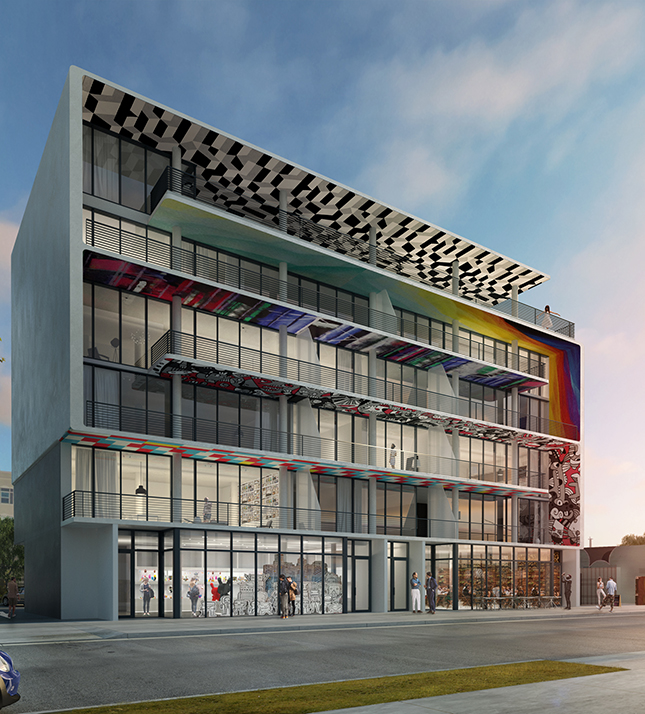
Wynwood condo development nearing sell-out as area heats up
By Ina Cordle
An 11-unit, upscale condo project under construction in the heart of Wynwood has sold nine, or 82 percent, of its units, underscoring demand for residential developments in the burgeoning, artsy Miami neighborhood.
Among the units placed under contract at 250 Wynwood is a 1,900-square-foot penthouse, sold for $1,065,000, or $560 a square-foot, setting a new record for the district, Gingi Beltran, an agent with Cervera Real Estate and sales director for the project told The Real Deal. The development, at 250 Northwest 24th Street, is the first new condo project to be built in the neighborhood since Wynwood Lofts in 2005, she said.
“This is the beginning of the residential movement to that area, and to be getting $560 a square-foot for a penthouse is huge in that area,” Beltran said. Though she declined to disclose buyers, and purchases will not close until the building is completed this summer, she said the buyers are local residents, New Yorkers and include a singer and a “gazillionaire” who has several other homes. 250 Wynwood is being developed by Miami-based Fortis Development Group, led by principals David Polinsky and Bradley Carlson. Carlson, from New York, has also placed a deposit on a penthouse, Beltran said.
The developers bought the site in November 2012 for $775,000, Miami-Dade property records show. Fortis obtained a $3.4 million construction loan from City National Bank of Florida, arranged by Aztec Group.
The site is behind Panther Coffee, and is in walking distance to Wynwood Walls, Wynwood Kitchen & Bar, Joey’s Italian Cafe, Zak the Baker and jugofresh.
“When people ask me what are the amenities in the building, I tell them Wynwood is the amenity,” Beltran said. “It’s a groovy mixture of art and nightlife, and everything is in walking distance. It’s a nine-block radius [from 20th Street to 29th Street], so you can do everything, and a lot of neighborhoods don’t offer that.”
Developers have increasingly taken notice of the former warehouse district, with an eye on future projects. Among them is New York developer Shahab Karmely of KAR Properties, who paid $12.5 million in December for a 1.03-acre site at 2050 North Miami Avenue. Karmely told The Real Deal earlier this month that he intends to expand his holdings in the arts district.
“In Wynwood we want to take our time and put in the right project,” he said. “We’re watching how Wynwood is evolving.”
A New York-based real estate investment firm founded by developers Jonathon Yormak and David Peretz is also proposing a 23,500-square-foot projecta aimed at transforming a Wynwood wholesale shoe warehouse into a trendy retail plaza with a rooftop lounge.
“We see it as the next Meat Packing District, Soho and Williamsburg,” Yormak told TRD in August. “We believe we are coming in during the second inning of a nine-inning game. What you are seeing now is just the beginning of what Wynwood will be in 10 years.” Sales of 250 Wynwood launched in December 2013, with non-penthouse units priced at $420 to $450 per-square-foot, Beltran said. One-bedroom units started in the $350,000 range, two bedrooms in the $600,000 range. Each unit features 10-foot ceilings with open living spaces, floor-to-ceiling windows and oversized private balconies, she said.
The ground-up development is designed by New York City architect Laith Sayigh. It will feature site-specific artwork chosen by Miami gallerist Anthony Spinello.
“We’re staying true to the neighborhood, with each canopy with a different mural, rather than making a building that has nothing to do with the neighborhood,” Beltran said. “Its kind of, almost, bringing in a more upscale living environment in Wynwood.”
[link to article]

SUBINDO!
By Paul Clemence
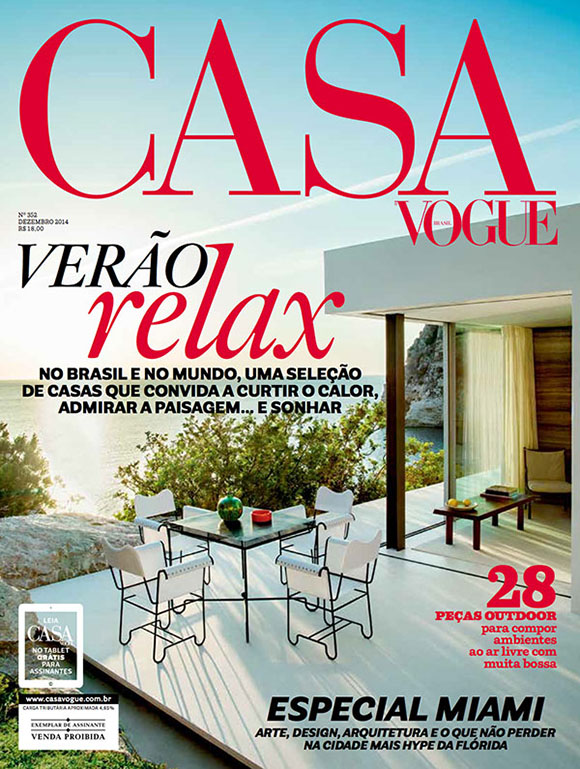
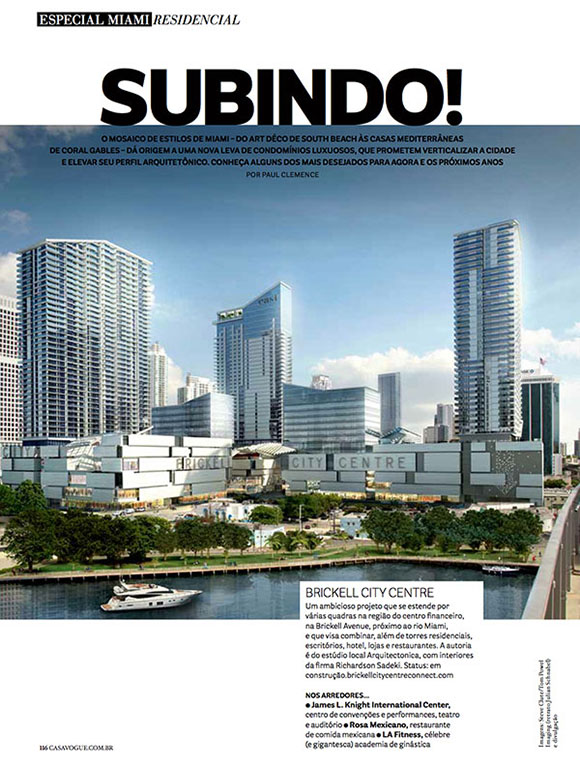

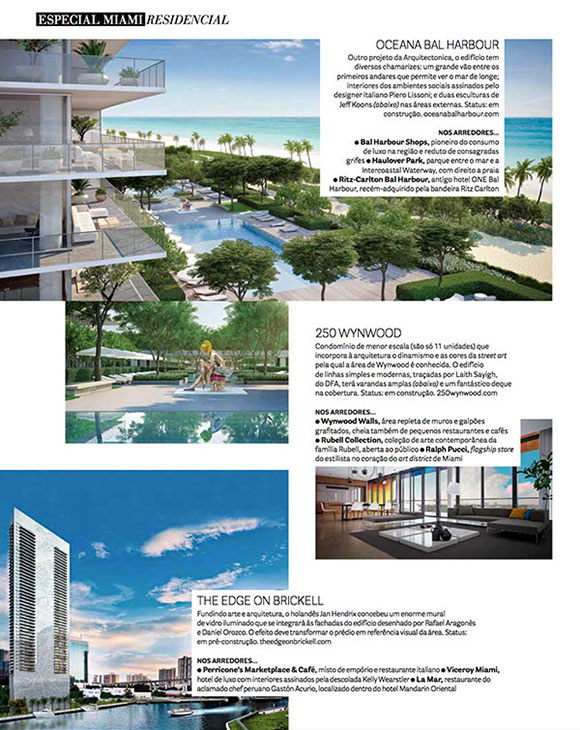


Anthony Spinello
By Anne Tschida
To call Anthony Spinello simply a gallerist would be a
misnomer. The 31-year-old has run a gallery in Miami
since he was in his early 20s, but these days he really
is much more of an arts producer.
Take, for instance, his plans for this year’s Art
Basel Miami Beach. The work of Kris Knight, a Toronto
painter, will be showcased in a solo exhibit in the Design District.
That burgeoning high-fashion location, which is not Spinello’s actual
gallery (that’s just west of Wynwood), is deliberate. Knight’s wistful
portraits of young men on the cusp of adulthood caught the eye
of the head of Gucci, who is using the paintings as inspiration for
clothing lines, including the upcoming 2015 Resort Collection.
Spinello will open another “pop-up” space in Miami Beach, in
the old Giant Motors building on Purdy Avenue. He will put on an
exhibit labeled “Auto Body,” with 50 female artists 35 years old and
younger, and including video and at least eight performances during
ABMB week.
Finally, visitors can stop by his two-story gallery and check
out artists on his roster, Miami lights such as Agustina Woodgate,
Antonia Wright, Santiago Rubino and Typoe.
Spinello was one of the only local galleries selected for Art Basel
Miami Beach, in 2012 and 2013. These exhibits — which really
are as much events as simply shows — point to Spinello’s latest
path, one that started back in the early oughts, when the 20-year-old
arrived in Miami from New York and dipped his toe into the nascent
art world.
Spinello opened his first gallery in his upstairs apartment on
North Miami Avenue in then-decrepit Wynwood. He’s since moved around, but the artists with him have always seemed to form a
family wherever they go. Spinello doesn’t just show their work,
he participates in developing it — often in cutting-edge forms of
installation, performance, street art and video. “I grew up with my
artists,” he says. Along the way, he has published a magazine, Dirty,
and produced site-specific projects in art centers such as Berlin.
“The artists I work with are as diverse as my interests,” he
says. “I’m interested in artists’ practices, in craftsmanship, in
development.”
The latter is what keeps Spinello in Miami. It’s a young and
developing art city, he believes, with “so much room for exploration
and innovation.”
Another project in development that reflects Spinello’s broad
scope: designing the façade of a new housing project, 250 Wynwood,
by commissioning locals and nonlocals to create original artwork for
all the exterior balconies.
Miami, says Spinello, “is still a bit of a playground.”
[download pdf]

The Residential Future of Wynwood
By Sean McCaughan
Wynwood, the former district of warehouses, garment wholesalers, and light industrial that has become an international street art mecca, is maturing into something else. Galleries and artist studios are being joined by high-end, hip retail and—in the ultimate sign of change—condos. Yes, Wynwood south of 29th Street will soon have something it has seen remarkably little of: residents. And if everything goes according to plan, these new neighbors will be the same young creatives who populate its streets on a daily basis.
A spate of construction is bringing some very sleek new apartments and condo buildings to the area, but the real change will happen under a new, dramatically overhauled neighborhood zoning code currently in the works. Both Wynwood Central, a mixed-use project with 69 rental apartments and a rooftop bar and pool area, and Fortis Development Group’s 250 Wynwood, a condominium with 11 larger units over ground-floor retail, will be the first new residential construction in Wynwood in over a decade. Those will likely be joined by 30 to 40 units in Fortis’s follow-up building next door, 230 Wynwood, that is still in the planning stages.
The architecture of these new projects, of course, is intended to contribute to the unique visual identity of the neighborhood. “We still want to do a little bit of daring architecture,” says David Polinsky, managing director of Fortis, referring to 230 Wynwood’s design, which includes deep balconies with undersides decorated by a group of artists selected by gallerist Anthony Spinello.
Over at Wynwood Central, a giant rooftop sign saying Wynwood will add some nighttime pizzazz and sparkle to the retro industrial look of the area. As the former associate editor of Curbed Miami, Emily Schmall, once quipped, “Can’t you just see the letters now, dancing in the moonlight?”
[link to article]

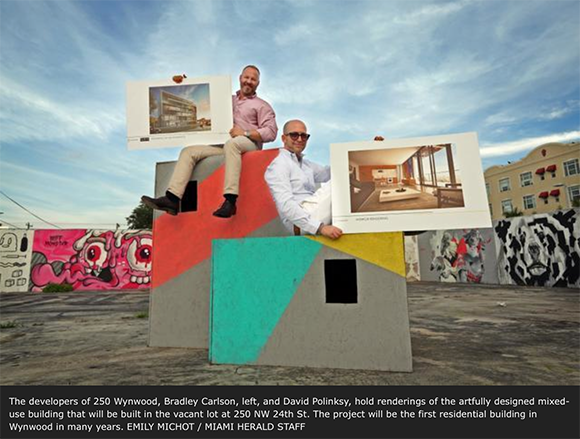
Now coming to Miami’s Wynwood district: condos
Friday June 13,2014 By Andres Viglucci
AVIGLUCCI@MIAMIHERALD.COM
In the evolution that has taken Wynwood from industrial wasteland to hipster mecca in the seeming blink of an eye, the artists who came looking for cheap studio space were just the first step out of the muck.
After them, in an accelerating process of adaptation, came the art galleries, the eye-grabbing graffiti murals, the artisanal coffee, the art-walk party mobs, and the conversion of dingy warehouses into stylish spaces for bars, restaurants and loft-like offices for the creative set.
Now there’s something else rising in Wynwood.
Apartments and — gasp! — condos.
For the first time since Wynwood became Miami's hippest ’hood, developers have plans to erect a half-dozen new buildings in the district. Proponents say the building plans, which mix residential units with work spaces and ground-floor shops, would add the last critical missing link in the rapidly diversifying neighborhood ecosystem: People who actually live there.
“I think it will change the perception of Wynwood,” said David Polinsky, whose 250 Wynwood, an 11-unit condo with ground-floor retail and terrace overhangs that will be decorated with curated graffiti, is set to break ground in the next few weeks.
“There is so much good will and enthusiasm about the neighborhood, but there are basically zero options for housing,” he said. “It can be a great place for young creative people to live and work. You can’t really think of another neighborhood where that’s going on in Miami.’’
Across the street from Polinsky’s property, several small warehouses have come down to make way for the eight-story Wynwood Central, which will combine 69 live-work rental apartments, a 420-space parking garage and three floors of retail and commercial space.
A few blocks away, on North Miami Avenue, New York developer Sonny Bazbaz is seeking zoning approval for a 12-story apartment and extended-stay hotel complex. On a vacant lot north of the famed Wynwood Walls, Goldman Properties, which helped launch the Wynwood renaissance, has won rezoning for a mixed-use building that could include 55 dwellings, a 100-room hotel and an event space described as “industrial chic.”
The Wynwood story seems to be following a well-worn script: artists and urban pioneers reclaim a neglected neighborhood, only to be displaced by rising prices and monied gentrifiers, erasing the very character that made it cool in the first place.
So there goes the neighborhood, right?
Actually, not so fast.
In what might be a radical departure for Miami, Wynwood developers say they are eschewing the usual hot-neighborhood development model of maximum exploitation with minimum care.
They have formally banded together with local entrepreneurs and new and longtime Wynwood property owners to devise a strategy that would foster affordable residential development while preserving Wynwood's unique flavor and the pedestrian-friendly scale of its streets.
“We’re trying to create for the first time in Miami a very comprehensive approach to how zoning will guide development of a neighborhood,’’ said Joe Furst, managing director for Wynwood at Goldman Properties and chairman of the new Wynwood Business Improvement District, which is overseeing the planning effort. “We all love what we’ve created in the neighborhood, and we’re trying to do it right.’’
Plenty of Space
The effort aims to remedy big drawbacks boosters say have held back Wynwood’s emergence as a full-fledged neighborhood: It contains little housing and few residents. Its warehouses are unsuited for residential conversion. And the district’s predominantly light-industrial zoning sharply limits housing density.
The Wynwood industrial district, between I-95 and the FEC tracks to the east and from 20th to 29th streets, has only about eight blocks of modest duplexes and small apartment buildings, plus a smattering of detached homes and a large homeless shelter, the Miami Rescue Mission. Two newer residential buildings, the rental Cynergi lofts and Wynwood pioneer David Lombardi’s Wynwood Lofts 36-unit condo, predate the current boom.
Within that defined zone, developers and property owners say, there’s plenty of space for new residential development; 60 percent of the district consists of vacant land, a BID survey found. But there are legal hurdles. The light-industrial zoning restricts housing to a live/work arrangement that requires residential floorspace to be clearly divided between either use.
Developers say zoning restrictions in effect require relatively large residential units, not the smaller, more affordable housing that would appeal to the young creative types who would make up the likely Wynwood residential market.
With the exception of Wynwood Central, which has large units up to 2,500 square feet, all the other projects have won or are seeking rezonings.
The BID, which represents the area’s 200 property owners, wants to see zoning restrictions loosened. But its leaders worry that a big wave of development could encourage warehouse demolition and overwhelm the neighborhood’s funky street ambiance.
The last thing they want, BID leaders and property owners like Lombardi and others insist, is to bring in intense high-rise development of the kind that has overtaken hot redevelopment zones like Brickell Village or Edgewater.
The BID, a city-approved group funded through a special property assessment, has commissioned planner Juan Mullerat of Miami firm PlusUrbia to draw up a master plan and zoning to guide Wynwood’s redevelopment.
The plan would continue to restrict new construction to eight stories in most of the district while promulgating a design aesthetic to mesh with the warehouses and the low-scale street grid. It calls for apartments upstairs and active storefronts on the sidewalk to promote pedestrian activity and capture the artists, designers, chefs and tech entrepreneurs already flocking to Wynwood.
To keep things affordable, BID leaders want to rezone most of the district, expanding housing density to 150 units per acre, from the current 36, to allow smaller units in modestly scaled buildings without obliterating the neighborhood. They also would like to see a parking minimum of 1.5 spaces per unit eased.
“This is what’s needed if we’re going to see Wynwood reach its potential as a living, working community with real creatives here eating, sleeping and collaborating 24 hours a day,” Lombardi said.
A Careful Balance
The city says it’s on board with the idea, but is awaiting a final BID draft. City planners warn that the fixes must strike a careful balance if its proponents wish to preserve Wynwood’s character.
“I’ve been hearing a lot about preserving the soul of Wynwood — it’s easy to latch on to that,’’ said Cesar Garcia-Pons, the city’s deputy planning director. “But the outcome could be the entirety of Wynwood being 12-story residential towers. Then it’s not Wynwood anymore.”
BID leaders seem acutely aware of the pitfalls. At a recent meeting, members debated how to encourage preservation of the warehouses and graffiti that have come to define Wynwood.
“If you don’t have a mechanism to protect the warehouses, before you know it, you have just another neighborhood,” said Oren Cohen, vice president of Mana Wynwood, which refurbished the old free-trade zone complex for use as video and sound and video stages. “There has to be a way of keeping the feel.’’
But rules requiring preservation of warehouses may not be feasible and could stifle Wynwood’s serendipitous evolution, Mullerat replied.
“To maintain the industrial feel is important, but these warehouses don’t necessarily need to remain,” he said. “One of the beauties of Wynwood is that it was accidental. That soul has sort of created itself. ’’
In the absence of clear rules or established templates, the developers of 250 Wynwood and Wynwood Central say they have gone to great pains to make sure their designs are in sync with Wynwood.
Polinsky, who is on the BID’s board, says his small building serves as a demonstration project for the neighborhood — edgy enough to break the mold of Miami condos, but sympathetic to its artsy surroundings. His New York architects, D-form-A, set glass-fronted units behind a pattern of rectilinear interlocking terraces overlooking the street. Blank walls on the sides echo the basic concrete construction of its warehouse neighbors.
To incorporate street art, Polinsky hired hot gallerist Anthony Spinello to select artists who will apply geometric, graffiti-style murals to the undersides of the terrace overhangs. The art will be visible from the sidewalk and frame residents’ views, but not blanket the building, Polinsky said.
Wynwood Central developers Marc Kovens and Shawn Chemtov are forgoing graffiti. But they hired Bloom Miami, a branding and design firm, to work with architects DNB Design Group and ensure their new building is “accepted” by its hip Wynwood neighbors, Bloom partner Darin Held said. That meant interviewing Wynwood entrepreneurs and creative lights and incorporating simple industrial design elements like factory-like neon signage into the building.
“We’re not looking to just come in and make a lot of money,” said Wynwood Central leasing agent Lyle Chariff. “I think what we’re doing will be a catalyst and the footprint for what’s going to happen.’’
Still, as developers snap up land and warehouses, prices in Wynwood are rising fast. Lots are selling for up to $300 a square foot. Owners have sunk considerable money into converting warehouses into shops and offices — in high demand as Wynwood becomes a serious place to do business.
That’s a boon to some longtime property owners who suffered through lean years and can now sell for millions. But rising rents means some art galleries and studios have been forced out, and more likely will follow, Mullerat said.
“The gentrification has already happened,” Mullerat said. “The market has pushed land values to levels that are not sustainable for some of the existing businesses.’’
But BID leaders and some longtime Wynwood business and property owners say the changes are, on balance, all to the good.
“This was the kind of place that, at sundown, you would tell your employees, ‘Get in your car and go home,’” said BID board member Albert Garcia, whose family business, Mega Shoes, an international maker of women’s fashion footwear, has been based in Wynwood since his parents founded the company 40 years ago. “Fast forward to today, and people are walking the sidewalks all hours of the day and night.’’
But Garcia, chairman of the BID board, said it’s also important that the history and DNA of the neighborhood be preserved even as it changes.
“We’re not a high-end mall. We are not a row of bars and restaurants catering only to nightlife. And we’re not an assortment of galleries, either. It’s not going to become Doral. We’re not trying to become Design District Junior. Our path is a little different, and I think it’s the most authentic,’’ he said.
“It’s going to evolve, and that’s OK.”
[link to article]

New Wynwood Lofts Aim To Be A 'Public Canvas'
Thursday, January 30, 2014, by Emily Schmall
In the fledgling Wynwood residential market, a new 36,000 square foot mixed use building designed by architects D-FORM-A called 250 Wynwood will be carved into 11 "generous" live/work units over six floors, including two penthouses, one with a crazy massive rooftop garden, in "interlocking finger schematics." Two retail spaces will occupy the ground floor. The building itself was "conceived as a public canvas,"D-Form-A says on its website, and renderings suggest the undersides of the building's eyebrows will bare the obligatory Wynwood murals. Public art installations curated by Spinello Projects on the exterior of the site will be changed every three years. The location is down the block from hipster dives Panther coffee and the Wynwood Walls, which (for some people) could be everything you'd need all wrapped up in one city block.
An older version of the design, courtesy D-FORM-A
[link to article]

Miami board approves Wynwood rezoning
Developer wants to construct area’s densest residential building
March 11, 2014 11:15 AM
A City of Miami board has allowed a developer in Wynwood to construct the densest building in the burgeoning neighborhood.
The Planning, Zoning and Appeals Board voted 7-1 in favor of developer Wynwood 250’s request for a zoning change giving it the ability to build one or more eight-story structures and up to 80 apartment units on a half-acre property on Northwest 24th Street, Daily Business Review reported. City staff had recommended a denial of the request. Wynwood 250, a partnership between David Polinsky and Bradley Carlson, previously announced plans to construct a six-story, 11-unit luxury condo building on about half of the property.
“What’s happening in Wynwood right now is exciting, but it’s been limited to adaptive re-use so far,” said attorney Steve Wernick, who represents Wynwood 250.
Miami architect Carl Levin is working with New York architect Laith Sayigh on project designs. [Daily Business Review] — Eric Kalis
[link to article]

Living With Art: 250 Wynwood
By John T. O'Connor
Just west of the exploding Edgewater neighborhood and south of the ever-changing Design District, Wynwood is a constantly morphing arts district currently hosting about 70 galleries, museums and collections. It's home to the infamous Wynwood walls, it buzzes during Art Wynwood and its former warehouses and factories are all but out of control when Art Basel makes greater Miami its home-base each December. All these things make Wynwood edgy, vibrant and a place creatives like to call home. But for all this burgeoning neighborhood does offer, one thing it lacks is housing that pays close attention to what this district is and what it wants to be. The thought of paint-splashed Wynwood doesn't conjure images of luxury high-rises with Big Box anchor tenants, but rather feels like small, mixed-use, live-work style developments that reflect the aspirations of the creative class, remaining more accessible than nearby alternatives.
Recently breaking ground is one of those developments exactly, with a design and style that feels as if it developed right from the energy that surrounds it. And in a way, it did. 250 Wynwood is the brainchild of Bradley Carlson and David Polinsky, founding partners of Fortis Developments. When looking for the perfect spot for a mixed-use development, Carlson and Polinsky were drawn to Wynwood by its urban edginess. "It was pretty evident that Wynwood was the place to be. It was already a thing," Carlson told us recently, "And clearly on the way to becoming something big. You could feel it in the air." The team saw not only the potential here, but clearly identified a hole in the market. "Wynwood felt like the Meatpacking District did in 1999 – gritty and full of potential," says Carlson. "It had galleries, clubs and plenty of places to eat, drink and shop. But after the fun, everyone vacated to other parts of the City. There was nowhere to live."
To design a building that would speak to those wanting to call Wynwood home, Polinsky and Carlson, after a long search, selected Laith Sayigh and his New York-based firm, D-form-A. Sayigh is principal of the New York City-based firm, and comes with an amazing background, having worked at Foster + Partners in London, Diller Scofidio and Renfro in New York, and SOM in San Francisco. For 250 Wynwood, D-form-A has designed a building that combines businesses on the ground level with 11 live-work style residences above. While true to the tenets of New Urbanism, the design somehow manages to avoid the trap of portraying itself as polished or uber-chic. Its five residential levels have long, deep terraces formed by two interlocking ‘E' formations pushing in from left and right. The result is dynamic enough right there, but because of this project's unique location, the group decided to really bring art into the mix. To that end, Polinsky and Carlson brought in Wynwood gallerist, Anthony Spinello, a trailblazing young curator who got his start in Wynwood, to choose the artists whose work will be represented in the project, from art that hangs in the public spaces to art painted on the exterior walls and ceilings of the upper terraces. In this way, the building reminds us of Warhol's last factory in New York, where canvases painted by Basquiat or Clemente leaned up against walls while Kieth Haring's painted, taxidermied elephant faced the front window for years. Make no mistake, 250 Wynwood is a brilliant idea, one that promises to capture the energy of the district and reflect it back, 24 hours a day.
The Fortis team did well in selecting D-form-A to bring their dream to life. Sayigh was able to figure out what the neighborhood wanted at this particular moment, while managing to make 10-foot ceilings, room-deep terraces and floor-to-ceiling glass all standard. This is akin to walking a sort of ‘design tightrope' that, when done properly, gives the building an air of cool. Where other architects in Miami might have opted for opulence, D-form-A has kept their finger on the pulse of Wynwood. 250 Wynwood, through its thoughtful program and design does not just play the part of urban infill, it becomes a generous contribution to the fabric of the city.
[link to article]

Low-Rise Wynwood Condo Project to Break Ground
Posted May 5th, 2014 by Felipe Azenha
Real estate is making a strong comeback in South Florida and developers have collectively announced nearly 200 new condo projects, most in Downtown Miami and Brickell. We’ll see how many of these projects will actually be built, but I estimate that about 15-20 condo projects have already broken ground. Most of the high-rise condos that are under construction can be found around Brickell, Downtown Miami, Edgewater and Coconut Grove.
Surprisingly there has been very little, if any, new construction in Wynwood in the last 5 years. What Wynwood has seen recently is adaptive reuse of existing warehouses that have been repositioned for retail- virtually no new residential density has been introduced to the area in the most recent real estate cycle.
It’s hard to argue that Wynwood is more of a destination than a neighborhood. Fifty-seven percent of all developable land in Wynwood is vacant land. With the exception of a handful of single-family and multi-family properties very few people actually live in Wynwood. Cynergi,Wynwood Lofts and the Filling Station (currently under construction) are the only buildings that have added residential density to Wynwood.
250 Wynwood will be the first new low-rise condominium project in Wynwood since Cynergi was completed in 2008. Developers David Polinsky and Bradley R. Carlson believe they will break ground on their 11-unit project within the next couple of months of all goes well with the permitting process.
250 Wynwood is exactly the small-scale development that Miami needs more of. The 6-story building with retail on the ground floor has been beautifully designed. The architect does a wonderful job of integrating the Wynwood mural arts aesthetic into the design. The live/work flexibility in uses is very appropriate for the neighborhood demographic. Even the smallest 1-bedrooms have 35-foot wide balconies and floor to ceiling glass. Perhaps the biggest selling point is that the project is located just 50 paces from Panther Coffee.
Here’s some more info about the project from the brochure.
The mixed-use project consists of two ground floor retail units and nine generously proportioned one and two bedroom condominiums ranging from 768 to 1602 square feet and priced from the mid $300,000’s to just over $600,000. There are two large penthouses, one with nearly 3000 square feet of interior space and a 2,500 square foot sky garden. Each unit boasts 10-foot ceilings, floor-to-ceiling glass exteriors, vast open live/work spaces with 8.5’ deep private balconies and secured parking. Each unit’s balcony will feature artwork curated by Wynwood gallerist and Art Basel exhibitor Anthony Spinello of Spinello Projetcs. “The idea was to create something that blends, with the neighborhood’s artistic and cultural context, including such elements as the Wynwood Walls,” explains architect Laith Sayigh.”
[link to article]

Gird Your Loins For The Condofication Of Wynwood
Thursday, May 1, 2014, by Sean McCaughan
Site work begins this week on 250 Wynwood which, along with the already-under-construction Wynwood Central, is the first new residential construction in Wynwood in like a decade. (this is the first condo, because Wynwood Central is rental) We showed off some old renderings back in January, but since then they've been updated, and the project has a new website with floor plans for your viewing pleasure.
With retail on the bottom, each floor will have two two-bedroom units and one studio with big, loft-like "great rooms", and the penthouses will have even bigger great rooms, with one giving access to a deliciously huge roof deck that seems like it will be perpetually rented out for parties and photo shoots and whatever. Heck, the roof deck has direct elevator access through double doors. Oh, and in typical Wynwood style 250 Wynwood will be covered in murals and wall art. The art will be 'curated' (which is such an over-used word!) by gallerist Anthony Spinello, and apparently it'll be filled with annoyingly bearded hipsters like the dude in the lobby rendering.
[link to article]
Miami Today | City pushes changes to allow Wynwood live-work project
May 8, 2014 By John Charles Robbins
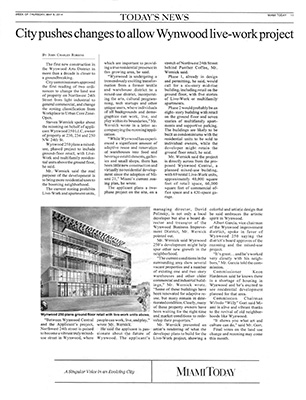
[download pdf]
250 Wynwood: Living at the Heart of Miami's Cultural Hub

[link to article]


